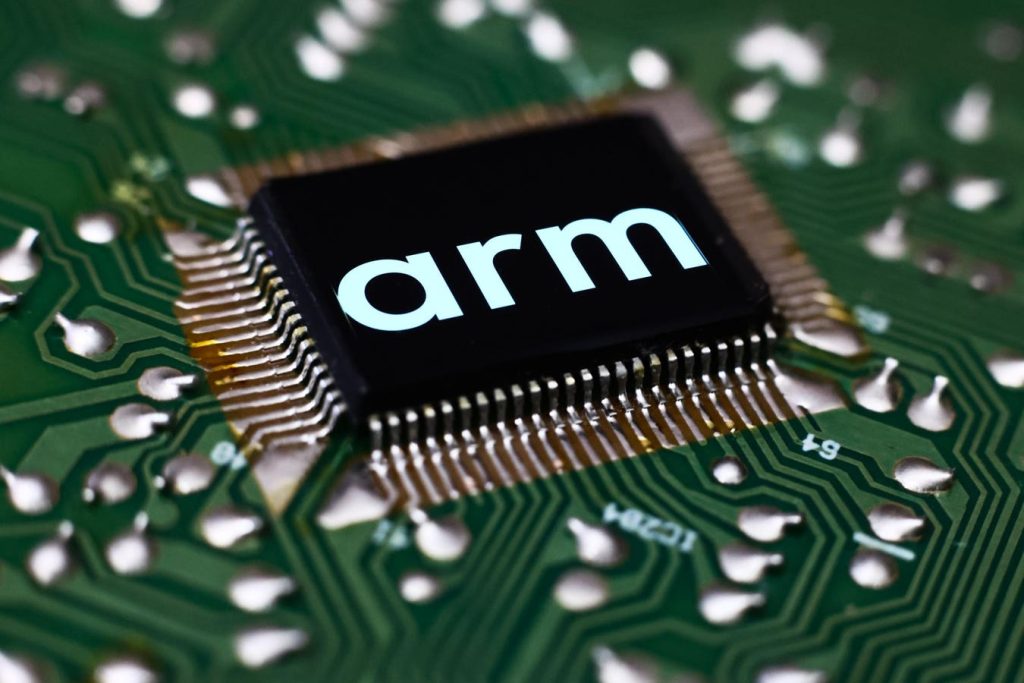Arm Holdings is the third-best performer of 2024 in AI-related semiconductor stocks with a 56% YTD return, behind only Nvidia and Taiwan Semiconductor. The stock is a market favorite as Arm’s heterogenous compute design has created a monopoly in mobile, primarily, yet Arm’s RISC architecture is also found in PCs, powers sensors and supercomputers. In total, over 280 billion Arm-based chips have been shipped dating back to the 1980s.
The latest Arm v9 architecture offers significant improvements in performance and efficiency, particularly for artificial intelligence (AI) applications. This has led to increased adoption by premium smartphone partners, and also with hyperscalers that are developing their own custom silicon for data center use.
The market is excited about Arm’s v9 architecture because it commands double the royalty rate with Arm receiving a higher percentage of the chip’s selling price when a manufacturer uses v9 designs. The estimated royalty rates for v9 are around 4%, compared to Arm’s blended 1.7% royalty rates for the prior generations – however, this is simply not enough to consistently accelerate Arm’s top-line growth to justify its valuation as $70+ billion more AI chips are sold this year. So even though Arm is leveraging its established royalty and licensing model through its extensive ecosystem to drive predictable future growth and a rather defensible bottom line, apart from the cyclical doldrums of the semiconductor industry, its growth story pales in comparison to some of its key customers.
Q1 Earnings Strong, Yet Q2 and FY25 Failed to Impress
Given the string of strong beat and raises from GPU leader Nvidia over the past several quarters, the market has been setting the bar high for AI-related stocks, including Arm. Despite beating Q1 estimates, Arm failed to meet high expectations as it guided for Q2 results below consensus.
Arm reported 39% YoY growth to a record quarterly revenue of $939 million in Q1. Looking ahead to Q2, Arm projected revenue between $780 million and $830 million, for flat YoY growth at midpoint, decelerating from Q1’s 39% print. Analysts had expected Arm to guide to $813 million in revenue for Q2, for YoY growth of 1%. Given the small growth rate, a miss feels odd given the trajectory of other AI stocks.
In Q1, licensing revenue rising 72% YoY and 14% QoQ to $472 million, offsetting a more than (9%) QoQ decline in royalties. Arm said that licensing “hit a record level as the proliferation of AI everywhere is driving more companies to make broad and long-term commitments to use Arm’s power-efficient technology in their future products,” while royalty revenues are benefitting from Arm v9, which commands higher royalties per chip.
With that said, Arm expects next quarter “to be the low point of the year due to the timing of revenue recognition from licensing,” while also being one of the “highest bookings quarters of the year.” Royalty revenue is also expected to accelerate from 17% YoY to the low-20% YoY range in the quarter.
Arm’s adjusted EPS guide also came in below consensus estimates for the quarter, with Arm projecting $0.23 to $0.27 in EPS, short of the $0.28 estimate. While these may seem like thin margins for a miss, Arm’s premium valuation offers little room for error.
For FY25, Arm guided for revenue between $3.8 billion and $4.1 billion, or $3.95 billion at midpoint, falling short of the $4 billion consensus estimate. This forecast points to YoY growth of 18% to 27%. Adjusted EPS was guided between $1.45 to $1.65, which at the midpoint fell short of the consensus estimate for $1.57.
Arm also guided down for royalty revenue growth, projecting royalty revenue growth in the low 20% range, compared to the mid-20% range previously. Licensing revenue is expected to increase in the mid-20% range, with Q2 expected to be the weakest quarter and Q4 the strongest.
Our firm has been quite vocal that IPOs are not worth the risk, stating “there is no riskier proposition than an IPO that is richly valued.” The liquidity event that an IPO becomes after its lockup expiration creates high risk for tech investors as individual investors are often up against a deluge of insider selling. The fact that Arm is an overpriced IPO that is missing estimates this early is a concern. GAAP operating margin also has contracted from 18.5% to 5.4% on a TTM basis, primarily from IPO-related expenses.
v9 Growth Decelerated Quickly, But Projected to Rebound
As a primary driver of royalty revenue growth, v9’s revenue is important to track as it commands double the royalty of v8, and features in “virtually all high-end data center chips” and a majority share in smartphones. For example, v9 underpins Nvidia’s Hopper series chips, Amazon’s Graviton chips, Microsoft’s Cobalt chips, and many more. Arm also sees v9’s increased adoption (and increase in royalty mix) and the ramp of CSS-based chips in the second half of the year as growth drivers.
In Q1, v9 accounted for 25% of net royalty revenue, up from 20% last quarter, and up from 15% two quarters ago. Smartphones contributed to 40% of royalty revenue in FY24 and was the first to adopt v9. Notably, the smartphone market is recovering right now — smartphone revenues grew 50% YoY despite a single digit increase in unit sales, demonstrating how increased adoption of v9 can quickly impact revenue growth.
However, on the backs of a QoQ decline in royalty revenue in Q1, v9 revenue growth has decelerated dramatically, despite increasing its mix share by 500 bp QoQ. Growth decelerated from 46% QoQ in Q4 to 14% QoQ in Q1, reaching $116.8 million.
v9 revenue growth is expected to reaccelerate to above 30% QoQ in Q2, and remain at that level in Q3 as royalty revenue returns to QoQ growth, with ~9% QoQ estimated for Q2 and ~12% QoQ for Q3. Management said it expects the 500 bp QoQ mix increase “to be the continued trajectory” moving forward, implying Q2’s mix at 30% and Q3’s at 35%. This V-shaped recovery in v9 revenues arises from this consistent increase in mix along with a return to QoQ growth around the 10% to low-teens range. As such, v9 royalties are projected to rise to ~$153 million next quarter, up 31% QoQ, a 17 percentage point acceleration.
Yet despite the reacceleration in v9 revenue growth, it still contributes only a fraction of the end-market value being added from chips built on the design. Meaning, while v9’s revenue is increasing by just $37 million QoQ, end market customers such as Nvidia are selling $2 billion more QoQ in GPUs built on v9. I’ve said this since 2021 – despite Arm’s designs powering 99% of the mobile market, or the most important AI GPUs available today, the revenue gains generated from its royalties are nowhere near the same ballpark as the growth and revenue generated by its customers.
x86 Will Make for Strong AI PC Competition
Arm dominates in the mobile market, with more than 99% market share, but in some of Arm’s smaller end markets, such as microprocessors, the company faces steeper competition from x86-based players AMD and Intel.
According to data from Mercury Research, in the microprocessor unit market, AMD gained 68 bp QoQ to 19.2% market share in Q2, while Intel gained 37 bp QoQ to reach 71.1% market share. Arm, on the other hand, saw a 105 bp QoQ decline in market share, dropping to 9.7% share.
At a closer look, Arm lost share against AMD and Intel in both notebooks and desktop microprocessors, yet gained share in servers.
· In notebooks, Arm lost 144 bp QoQ, falling from 12.8% share in Q1 to 11.4% share in Q2. AMD’s notebook share rose 121 bp QoQ to 18.0%, while Intel gained 23 bp QoQ to 70.6% share.
· In desktops, Arm lost 31 bp QoQ to 5.9% share, AMD also lost 83 bp QoQ to 21.6% share, while Intel’s share rose 113 bp QoQ to 72.5%.
· Servers were the only segment where Arm’s share grew in Q2, rising 41 bp QoQ to 6.7%. AMD’s share rose 40 bp QoQ to 22.5%, while Intel lost 81 bp QoQ to 70.8% share.
Notably, it’s premature to say how Arm-based PCs will do as more AI features are integrated into laptops. MacBooks switched from Intel’s x86-64 processors to Apple’s system on a chip (SoC) based on Arm 64 architecture. Arm offers much lower power consumption and generates less heat due to being a Reduced Instruction Set. The M2 is built on Taiwan Semi’s 5nm process with 100GB/s memory bandwidth and 24 GB of unified memory. When the M2 was released in 2022, Apple claimed 1.9X CPU performance at the same power. At the same performance level, Apple claims the M2 uses ¼ the power as x86.
From there, the M3 MacBook Air was released this year with Apple stating it’s 13X faster than an x86 Intel powered MacBook. The Arm-based system on a chip (SoC) combines a CPU and a GPU with a 16-core Neural Engine for what Apple is calling the “World’s Best Consumer Laptop for AI.”
Traditionally, Arm’s architecture was viewed as the best choice for mobile and Intel’s x86-64 as the best choice for the data center and PCs. However, we are on the precipice of going through a major shift to where Arm architecture will compete more directly with x86 architecture for PCs. This kicked off with Qualcomm’s Snapdragon Elite X, and will be further tested when AMD and Nvidia release Arm-based PC systems in 2025.
Arm’s Growth Pales in Comparison to Customers
Arm’s value to the semiconductor industry is arguably indispensable, yet the stock trades at a premium valuation. The company is currently at highest top-line multiple in the entire semiconductor industry, even as its revenue growth pales in comparison to key chip customers.
Arm trades at more than 33x forward revenue, a 40% premium to Nvidia’s 24x forward revenue multiple. The industry’s other most expensive names, and those with the most AI exposure trade at lower top-line multiples, with Monolithic Power at 19.6x forward revenue, and AMD at just 8.9x forward revenue.
Arm’s expected revenue growth of 23% for fiscal 2025 is not the most impressive in the industry. Astera Labs leads with 200% estimated revenue growth, although it’s coming off an extremely small base of less than $100 million per quarter. Yet, Nvidia is expected to nearly double its revenue with 97% estimated growth, essentially adding $60 billion YoY driven by GPU sales, on a very large revenue base.
Arm does not and will not share a similar hypergrowth profile from AI like Nvidia, which has seen ‘hockey-stick’ growth over the past six quarters, rising from more than $4 billion at the start of fiscal 2024 to potentially more than $25 to $26 billion in Q2 fiscal 2025. Arm, on the other hand, did not even add $300 million in revenue in that time frame.
For the entirety of 2024, Nvidia, AMD, and more of Arm’s key customers are likely selling more than $70 billion in additional AI chips this year, whereas Arm is only adding $740 million in revenue, or barely more than 1% of its customers’ sales increase.
While Arm’s royalty and licensing model offers more predictable revenue growth in a cyclical industry, it does not share the same operating leverage or margin profile to quickly grow into its premium top-line and bottom line multiple. Nvidia has visibly demonstrated its ability to capture much higher ASPs with each generation and drive significant operating leverage, rising from a 30% operating margin to 65% in four quarters while driving >600% bottom line growth.
Given this tremendous strength on the bottom-line, Nvidia trades at 43x forward earnings, with growth of 110% expected this year. However, Arm trades at nearly double that multiple, at almost 81x forward earnings, with just 23% growth expected. AMD and TSM both trade at much lower multiples for EPS growth in the 26% to 27% range.
Conclusion
We’ve seen excitement over Arm’s AI opportunities and boosts to licensing fees and royalties, but our contention is that, similar to mobile, it’s better to own the AI leaders who license Arm’s technology. Investors have quite a few choices for AI stocks with stronger growth rates and cheaper valuations, rather than own Arm. Frankly, the valuation on Arm remains absurdly expensive, double or more than double the most-expensive chip stocks, including Nvidia.
There have been a few data points that have emerged since our last update on Arm in March 2024, and Arm’s Q2 and FY25 revenue guide also disappointed by falling short of analysts’ expectations, a stark contrast to the billion-dollar beats and raises from Nvidia.
We have been closely tracking a semiconductor name with tie-ins to the AI PC industry and Nvidia, and recently added this name to our portfolio. Our premium members will receive real-time trade alerts on this stock, alongside the rest of our AI-focused portfolio. Learn more here.
If you would like notifications when my new articles are published, please hit the button below to “Follow” me.
Read the full article here








